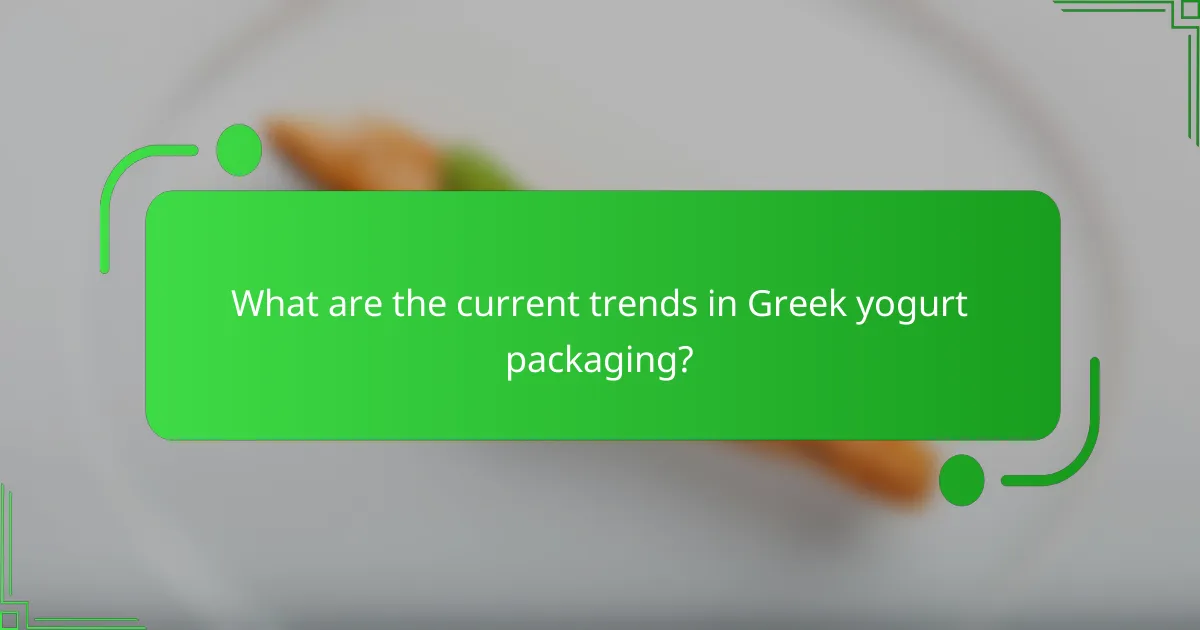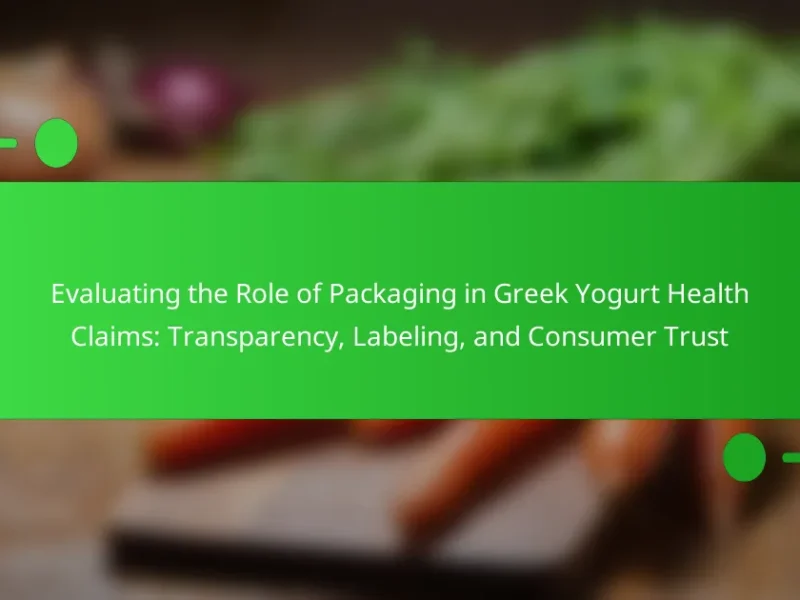Greek yogurt packaging is evolving to meet consumer demands for sustainability, convenience, and innovative design. Current trends highlight the use of eco-friendly materials to attract environmentally conscious buyers, while single-serve options cater to on-the-go lifestyles. Resealable containers offer portion control, enhancing user convenience. Additionally, brands are employing vibrant designs and transparent packaging to capture attention and build trust with consumers. These trends underscore a significant shift towards aligning packaging strategies with consumer preferences in the food industry.

What are the current trends in Greek yogurt packaging?
Current trends in Greek yogurt packaging include sustainability, convenience, and innovative designs. Brands are increasingly using eco-friendly materials to appeal to environmentally conscious consumers. Single-serve packaging options are popular for on-the-go consumption. Resealable containers enhance convenience for consumers who prefer portion control. Eye-catching designs and vibrant colors are being used to attract attention on store shelves. Additionally, transparent packaging allows consumers to see the product inside, fostering trust. These trends reflect a shift towards meeting consumer preferences for convenience and sustainability in food packaging.
How is convenience influencing Greek yogurt packaging designs?
Convenience is significantly influencing Greek yogurt packaging designs by prioritizing user-friendly features. Packaging is now designed for easy opening and resealing. Single-serve containers are becoming more common to enhance portability. Lightweight materials are used to reduce bulk and improve handling. Clear labeling is emphasized for quick identification of flavors and nutritional information. Many brands are incorporating spoon attachments to eliminate the need for additional utensils. Eco-friendly designs are also gaining traction, aligning convenience with sustainability. These trends are driven by consumer demand for quick, on-the-go options that fit busy lifestyles.
What packaging formats are considered convenient for consumers?
Convenient packaging formats for consumers include single-serve cups, resealable containers, and flexible pouches. Single-serve cups offer portion control and ease of use. Resealable containers maintain product freshness and allow for multiple servings. Flexible pouches are lightweight and easy to store. These formats cater to on-the-go lifestyles. According to a study by Mintel, 68% of consumers prefer packaging that is easy to open. This preference highlights the importance of convenience in packaging design for yogurt products.
How do portion sizes affect consumer preferences in packaging?
Portion sizes significantly influence consumer preferences in packaging. Smaller portion sizes often appeal to health-conscious consumers. They provide a sense of control over calorie intake. Larger portion sizes may attract families or those seeking value. Packaging that highlights portion sizes can enhance product appeal. Research shows that consumers prefer convenient, single-serving packages for on-the-go consumption. A study by the Journal of Consumer Research indicates that clear portion size labeling increases purchase likelihood. This demonstrates the importance of portion sizes in consumer decision-making.
What role does functionality play in Greek yogurt packaging?
Functionality in Greek yogurt packaging is crucial for enhancing user experience and product preservation. Functional packaging includes features like resealable lids, portion control, and easy-to-open designs. These elements cater to consumer convenience and on-the-go lifestyles. For instance, resealable lids allow for multiple servings, reducing waste. Additionally, packaging that maintains freshness extends shelf life, which is vital for dairy products. Studies show that consumers prefer packaging that simplifies their consumption habits. Overall, functionality directly impacts consumer satisfaction and brand loyalty in the competitive yogurt market.
What features enhance the functionality of Greek yogurt packaging?
Tamper-evident seals enhance the functionality of Greek yogurt packaging. These seals ensure product safety and integrity. They provide a visual indicator of whether the product has been opened. Easy-to-open lids improve user convenience. They allow consumers to access the yogurt without hassle. Resealable packaging extends freshness after opening. This feature helps maintain product quality for longer periods. Portion control cups offer convenience for on-the-go consumption. They cater to busy lifestyles and promote responsible serving sizes. Clear labeling with nutritional information supports informed consumer choices. This transparency builds trust and encourages repeat purchases.
How do packaging materials impact the preservation of Greek yogurt quality?
Packaging materials significantly impact the preservation of Greek yogurt quality. They determine the yogurt’s exposure to light, oxygen, and moisture. High-barrier materials can protect yogurt from these elements, extending shelf life. For instance, opaque containers limit light exposure, preventing degradation of sensitive nutrients. Additionally, airtight seals reduce oxygen ingress, which can lead to spoilage. Research indicates that yogurt stored in high-quality packaging retains its freshness longer than yogurt in inferior materials. Studies show that packaging influences not only the taste but also the texture and nutritional content of Greek yogurt.
Why are consumer preferences crucial for Greek yogurt packaging trends?
Consumer preferences are crucial for Greek yogurt packaging trends because they directly influence design and functionality. Packaging must align with consumer demands for convenience and sustainability. For instance, a 2021 survey indicated that 70% of consumers prefer eco-friendly packaging. Additionally, consumers seek portion control and resealability features, impacting packaging choices. Brands that adapt to these preferences often see increased sales and customer loyalty. Therefore, understanding consumer preferences shapes effective packaging strategies in the Greek yogurt market.
What factors contribute to consumer preferences in yogurt packaging?
Consumer preferences in yogurt packaging are influenced by several key factors. First, convenience plays a significant role. Easy-to-open packaging and single-serve options are preferred by consumers for on-the-go consumption. Second, functionality is important. Packaging that preserves freshness and prevents spills is highly valued. Third, sustainability is increasingly a factor. Eco-friendly materials attract environmentally conscious consumers. Fourth, visual appeal matters. Attractive designs and clear labeling enhance consumer interest and trust. Lastly, price influences preferences. Competitive pricing can sway consumer choices towards specific brands. Research indicates that these aspects collectively shape consumer decisions in yogurt packaging.
How do branding and aesthetics influence consumer choices?
Branding and aesthetics significantly influence consumer choices by shaping perceptions and emotional responses. Effective branding creates a recognizable identity that consumers trust. Aesthetic elements, such as color and design, attract attention and evoke feelings. Research shows that 93% of consumers make purchases based on visual appearance. Packaging aesthetics can enhance the perceived quality of a product. In the context of Greek yogurt, appealing packaging can differentiate brands in a competitive market. Brands that invest in attractive designs often see increased sales and customer loyalty.
How do sustainability concerns affect Greek yogurt packaging trends?
Sustainability concerns significantly influence Greek yogurt packaging trends. Manufacturers are increasingly adopting eco-friendly materials. This shift includes biodegradable and recyclable packaging options. Consumer demand for sustainable practices drives these changes. Research shows that 66% of consumers prefer brands with sustainable packaging. The yogurt industry is responding by reducing plastic use. Brands are exploring alternative materials like glass and plant-based plastics. This trend aligns with broader environmental goals and consumer preferences.
What sustainable materials are being adopted in Greek yogurt packaging?
Biodegradable plastics and recycled materials are being adopted in Greek yogurt packaging. Companies are increasingly using plant-based plastics made from corn starch or sugarcane. These materials reduce reliance on fossil fuels and minimize environmental impact. Additionally, recycled PET (rPET) is gaining popularity. rPET is made from post-consumer plastic waste and can be recycled multiple times. These sustainable practices align with consumer demand for eco-friendly packaging. Research indicates that 70% of consumers prefer brands that use sustainable packaging. This trend reflects a broader commitment to environmental responsibility in the food industry.
How are brands responding to consumer demands for eco-friendly packaging?
Brands are increasingly adopting eco-friendly packaging to meet consumer demands. Many companies are shifting to biodegradable materials. This change addresses growing environmental concerns among consumers. Research indicates that 72% of consumers prefer sustainable packaging options. Brands are also reducing plastic use in their products. Some are implementing recyclable packaging designs. This approach enhances brand loyalty and attracts eco-conscious customers. Additionally, brands are investing in innovative packaging technologies. These efforts reflect a commitment to sustainability in the food industry.
What innovations are shaping the future of Greek yogurt packaging?
Innovations shaping the future of Greek yogurt packaging include sustainable materials, portion control designs, and smart packaging technology. Sustainable materials like biodegradable plastics and recyclable containers reduce environmental impact. Portion control designs cater to on-the-go consumers by offering single-serve options. Smart packaging technology incorporates QR codes for traceability and freshness indicators. These advancements enhance convenience and align with consumer preferences for sustainability and functionality. The shift towards eco-friendly packaging is driven by increased consumer awareness about environmental issues. Research from the Food Packaging Forum highlights that 73% of consumers prefer brands with sustainable packaging.
How are technology advancements influencing packaging solutions?
Technology advancements are significantly influencing packaging solutions by enhancing sustainability and functionality. Innovations such as biodegradable materials reduce environmental impact. Smart packaging technologies provide real-time information about product freshness. Automation in packaging processes increases efficiency and reduces costs. Advanced printing techniques allow for more vibrant and informative designs. These improvements cater to consumer preferences for convenience and eco-friendliness. For example, the use of resealable packaging in yogurt products enhances usability. Research indicates that 70% of consumers prefer sustainable packaging options.
What are the emerging trends in smart packaging for Greek yogurt?
Emerging trends in smart packaging for Greek yogurt include interactive labeling, freshness indicators, and sustainable materials. Interactive labels enhance consumer engagement by providing recipes and nutritional information through QR codes. Freshness indicators utilize sensors to signal when the yogurt is nearing expiration, ensuring optimal quality. Sustainable materials are increasingly used to reduce environmental impact, aligning with consumer preferences for eco-friendly products. The market for smart packaging is projected to grow significantly, indicating a strong demand for these innovations in the dairy sector.
What best practices should brands follow for effective Greek yogurt packaging?
Brands should prioritize clarity, sustainability, and convenience in Greek yogurt packaging. Clear labeling enhances consumer understanding of nutritional content. Using recyclable materials aligns with growing environmental concerns. Resealable packaging offers convenience for on-the-go consumption. Portion control options cater to diverse consumer needs. Eye-catching designs can attract attention on retail shelves. Compliance with food safety regulations ensures product integrity. Research indicates that 74% of consumers prefer eco-friendly packaging options.
The main entity of this article is Greek yogurt packaging. The article explores current trends in Greek yogurt packaging, emphasizing convenience, functionality, and consumer preferences. It highlights the increasing use of sustainable materials, innovative designs, and features that enhance user experience, such as single-serve options and resealable containers. Additionally, it discusses how consumer demand for eco-friendly practices and clear labeling influences packaging choices, ultimately impacting brand loyalty and market success. Key insights include the importance of portion sizes, the role of technology in packaging innovations, and best practices for effective packaging strategies.


